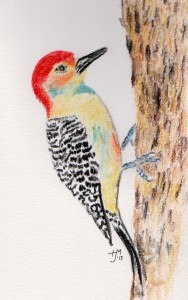“My” Birds
It’s silly and I know it. There’s no logical reason, but try as I might, I fall victim to it again and again. Anthropomorphism.
Giving human characteristics to non-human creatures is hardly new. The term comes from the Greek words “anthropos” (human) and “morphe” (shape), but this notion is universal. Still, that’s no excuse.
At the moment, the animal in question is the Red Bellied Woodpecker. The Sibley Field Guide to Birds of Eastern North America describes them as “common to deciduous woods”, but it’s only this year that they’ve become regular visitors to my suet feeder.
The Red Bellied is almost silly in its gaudiness. At about nine inches (22.9 cm) tall, it makes its presence known visually when it arrives. Feathers on its back are a stark barred pattern of black and white. From the neck up, the plumage appears borrowed from an entirely different bird: much of it is cream colored, and males sport a brilliant red nape and head. Even naming them Red Bellied seems silly, since the blush of red on the belly will rarely if ever be visible to the birder.
But for reasons I can’t quite explain, this oddball makes me smile every time I see him. And those times are often, since I seem to have kept my suet supply stocked at the right time. Early in the spring the Red learned, as birds do, that there was a good source of food available. His kind is found in forests up through Canada, but since the discovery of the suet, “my” woodpecker has gone from being an infrequently glimpsed visitor to one who knows exactly where the good silver is kept.
Then there is the call. I have never found written descriptions of calls to be very helpful, and writing the sounds as “chrrp” and “tchp, tchp” doesn’t seem to clarify things much. Luckily, there are online sources such Cornell University’s wonderful http://allaboutbirds.org that allows visitors to hear the call in a way that could never be matched in words. The Red has a call that is a long way from melodious, a kind of gurgling shout.
Between the shocking plumage and the distinct, nearly absurd call, I feel lucky that this woodpecker has chosen me. When my children ask, “What in the world is that sound?” I simply reply, “Oh, that’s my buddy, the Red Belly.” It’s nonsense to believe the bird knows or cares that I even exist, let alone harbor any notion of friendship, even in the highly unlikely case it were even possible to have such feelings. Still the silliness of anthropomorphism is deeply ingrained in us. Logical or not, seeing “my buddy” at my feeder makes me happy. I’ll save cold logic for another day.







